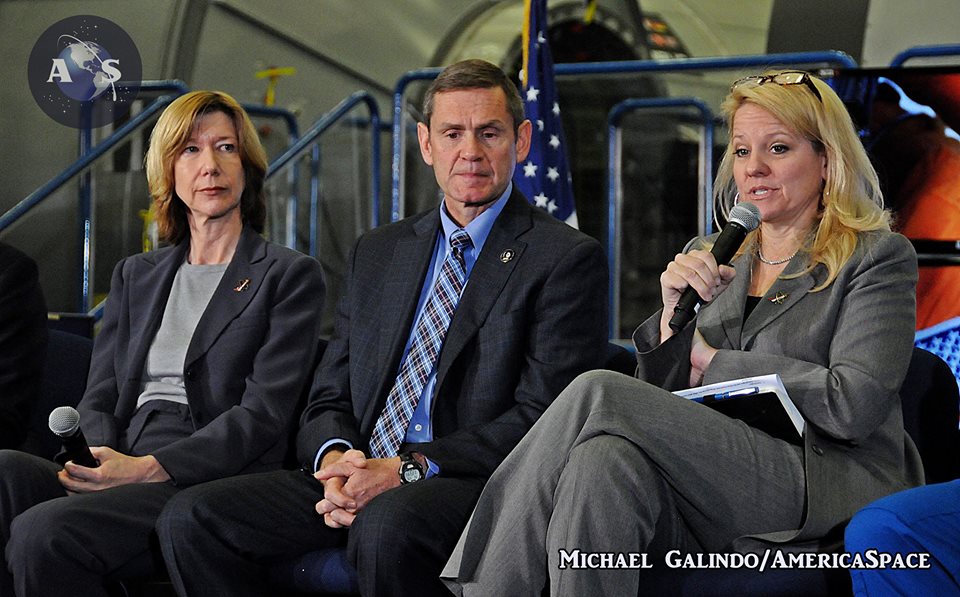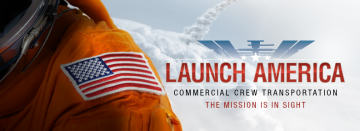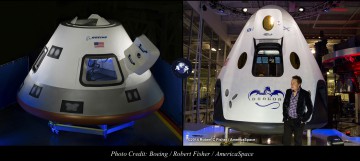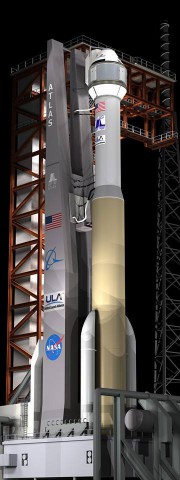
Four months after NASA selected Boeing and SpaceX as the winners of the Commercial Crew transportation Capability (CCtCap) phase of the Commercial Crew Development (CCDev) program—with total contracts valued at $6.8 billion—six key leaders from NASA and its industrial partners discussed both the current state of affairs and the next steps today (Monday, 26 January), as America prepares to once more launch U.S. astronauts aboard a U.S. spacecraft from U.S. soil by 2017. It was specifically highlighted that both companies are on track with their respective vehicles and are expected to play a significant role in low-Earth orbit operations over the next decade, with Boeing expected to fly the U.S. Crew Vehicle (USCV)-1 mission in 2018.
Held in the cavernous expanse of Building 9 at the Johnson Space Center (JSC) in Houston, Texas—the home of the Space Vehicle Mockup Facility (SVMF)—and surrounded by large training components of the International Space Station (ISS) and the Orion Multi-Purpose Crew Vehicle (MPCV), NASA Administrator Charlie Bolden expressed his pride in the agency’s accomplishments since the retirement of the shuttle fleet in July 2011. He noted that the reusable orbiters “had an amazing 30-year run,” but that it was imperative for NASA to fly again “as soon as possible from U.S. soil,” directing specific praise toward President Barack Obama for his leadership. Mr. Bolden, of course, is a former shuttle astronaut, having flown four missions in the 1980s and 1990, including the final flight before the Challenger tragedy, the deployment of the Hubble Space Telescope (HST), and the first joint U.S.-Russian piloted space voyage since Apollo-Soyuz.
Of the six panelists on the stage for today’s news briefing, half had actually flown in space. Joining Bolden was incumbent JSC Director Ellen Ochoa, herself a veteran of four shuttle flights, and the Astronaut Office’s liaison to the Commercial Crew Program, astronaut Mike Fincke, who is currently the most flight-experienced U.S. spacefarer, with over 381 days in orbit. Yet there were numerous active-duty shuttle and ISS fliers in the room, including Megan McArthur, Peggy Whitson, Mark Vande Hei, Karen Nyberg, and Chief Astronaut Bob Behnken, and Mr. Bolden stressed to them that it was their generation which would most likely fly aboard Boeing’s CST-100 and SpaceX’s Dragon V-2 crew vehicles in the next several years.

Sharing the stage with Mr. Bolden, Dr. Ochoa, and Col. Fincke were John Elbon, vice president and general manager of Boeing Space Exploration; Gwynne Shotwell, present and chief operating officer of SpaceX; and Kathy Lueders, NASA’s Commercial Crew Program manager. In her opening remarks, Ms. Lueders explained that the arrival of Boeing and SpaceX’s vehicles in an operational configuration from 2018 will allow for an expansion of the U.S. Orbital Segment (USOS) to four astronauts, thereby doubling the available crew time for science from 40 to 80 hours per week. According to NASA’s most recent Flight Planning Integration Panel (FPIP) documentation, published last month, the first U.S. Crew Vehicle (USCV-1) is currently scheduled for launch in May 2018 and will remain attached to the ISS for six months, spanning Expeditions 54, 55, and 56.
In today’s briefing, it was revealed that the USCV-1 mission will be flown by Boeing’s CST-100, and according to the FPIP its four-member crew will include a mixture of three USOS astronauts and one Russian cosmonaut. This flight is expected to mark the beginning of the end of U.S. reliance upon Russia for seats aboard their Soyuz spacecraft, with Mr. Bolden telling his audience at one stage—with scarcely a hint of humor—that “I don’t ever want to have to write another check for Roscosmos.” That said, he was aware that NASA was removing a major source of revenue from the Russians, but felt that they understood the critical importance of having a redundant crew capability and would be “perfectly happy” with the initiative.

In fact, the capabilities of both the CST-100 and Dragon V-2 are expected to mirror those of Soyuz, by following the same “first-day rendezvous” profile, docking within a few hours of liftoff, spending about six months in orbit, and landing approximately five or six hours after departing the ISS at the end of their respective missions. Under the terms of their agreements with NASA, both Boeing and SpaceX must perform at least one unpiloted and one piloted test flight to verify that their spacecraft can successfully dock at the ISS and demonstrate a satisfactory level of systems performance. This will pave the way for at least two, and as many as six, crewed, post-certification missions to enable NASA to meet its crew rotation requirements aboard the station.
Current plans anticipate unpiloted orbital flight tests as soon as April 2017, followed by crewed orbital flight tests the following summer, leading up to the long-awaited USCV-1 in May 2018. At the same time, Mr. Elbon told his audience that the construction of the Crew Access Tower for the Atlas V launch pad was well underway. He added that Boeing’s unpiloted CST-100 test will occur on the 74th Atlas V mission, followed by the piloted test on the 80th. Given that the Atlas V recently concluded its 52nd flight with last week’s launch of the newest Mobile User Objective System (MUOS-3) from Cape Canaveral Air Force Station, Fla.—and with eight more Atlas Vs slated to fly in 2015 alone—this would certainly seem to sit well with a mid-2017 target.

Asked about the NASA/industry crew composition of these missions, Mr. Elbon explained that having a Boeing test pilot aboard would be in keeping with their flight test heritage, whilst Ms. Shotwell stressed that the Dragon V-2 is “an extraordinarily easy vehicle to operate,” but acquiesced that the NASA astronauts needed to feel comfortable with its design and operation. She responded to one question by pointing out that SpaceX is still working through planning for its opening flight test and is trying to find the right balance of NASA and SpaceX crew members aboard the mission. In terms of when and how the first NASA crew members will be assigned to the orbital flight tests, Dr. Ochoa said that an initial cadre of astronauts would be named first, to better understand the training requirements, and from that pool the first crew would be assembled. In other words, she did not expect individuals to be announced in the first instance—as was the modus operandi throughout the shuttle era—but instead selected from within the cadre.
The vision, of course, is far broader, as highlighted with particular eloquence and enthusiasm by Mr. Bolden. With Mars considered to be “the horizon goal,” and his own belief that humanity is now less than 20 years away from reaching the Red Planet, he felt strongly that NASA’s deep-space exploration initiative would not be possible without handing over the reins of low-Earth orbital operations to private companies. He expressed a fervent hope that by the time the ISS reaches the end of its current lifetime in 2024, he expects “the world of low-Earth orbit to belong to industry,” with NASA developing “an infrastructure in cislunar space,” which would serve as a “proving ground” for expeditions further afield.
Even though the first test flights are more than two years away, the excitement in Building 9 today was tangible and could be felt in the voices of the six panelists. “I don’t think there is a time in history when there are more exciting things happening,” said Mr. Elbon, pointing to the “incredible science” being undertaken aboard the ISS, as well as the steadily maturing Commercial Crew and Cargo programs. “Not a hoax, not a myth, not a dream,” was Mr. Bolden’s summary. “It really is happening!”
Want to keep up-to-date with all things space? Be sure to “Like” AmericaSpace on Facebook and follow us on Twitter: @AmericaSpace




On another site the timeline given indicates that SpaceX will be ready almost a year before the USCV-1 flight. Is this U.S. Crew Vehicle designation internal to Boeing or is it a NASA thing and does that really mean they’re going to just sit on the SpaceX design and hand Boeing the checkered flag and first flight kudos?
The SpaceX timeline is also more spread out with abort tests this year followed by test flights in 2016. All of Boeing’s tests are crammed into 2017. I think SpaceX is more realistic.
SpaceX is a clear and present danger to Old Space – in this case Boeing and NASA. As such SpaceX is kept at arms length whenever possible, while Boeing is quite good at snuggling up close.
Well, that’s one point of view.
Here’s another. SpaceX has been perennially 2 years late in meeting every commitment it’s made, when it did. That SpaceX is approaching a year since it was supposed to finish its CCiCap milestones, yet 2 1/2 of those remain, is only the latest example. Boeing completed all of its CCiCap milestones six months ago. All the more galling is that NASA didn’t impose the CCiCap milestones and funding. SpaceX, like Boeing and Sierra Nevada, created those milestones and the funding that went with them. Why is SpaceX punctually challenged? I think this largely due to inexperience on SpaceX’s part.
Boeing demonstrated during CCiCap that it fully understood what it could do for a given amount of funding and in the time allotted. That is why it is the prime. SpaceX demonstrated that it didn’t understand that. So it’s not prime.
Space shuttle was 2 to 3 years late. Apollo Capsule had to be redesigned after the Apollo 1 fire. So, it was late but still made President’s Kennedy’s deadline. How many aircraft have Boeing built that has been late by a year to several years? Your point is mute. That just means that designing & flying aircraft/spacecraft is hard.
If SpaceX wouldn’t put those abort tests in CCiCAP, they wouldn’t be late. Because it is really a CCtCAP milestone. Suppose if SpaceX wouldn’t have been chosen. Then, they still would’ve had the abort tests left. Which, upon successful conclusion, they could still finish their Crew Dragon on their own time. Smart move. Sierra Nevada still has a glide test left. Musk said several years ago that Boeing would be one of the finalist in CCtCAP selection.
Art,
Yes, in the late 70’s to early 80’s, NASA was late in completing the world’s first, and still only, crewed, winged spacecraft powered by high-performance (Isp), Lox-H2 throttleable rocket engines. NASA built and, on Apollo 8, flew the Apollo spacecraft to the Moon well before the end of the 1960’s. That the spacecraft had some of its systems redesigned and still made that deadline only makes NASA’s feat all the more impressive.
Being was on-time with the B-777, at the time the most advanced and complicated airliner ever. But you’re right; Boeing was late in delivering the B-787, the world’s first composite airliner that is 20% more efficient than current state-of-the-art. Technical innovation can at times take longer than planned. And Boeing was 5 months late in finishing its CCiCap milestones.
If SpaceX were building spacecraft or launchers even approximating something so innovative as a space shuttle, chemical rocket engines with a greater than 450 sec. Isp,, a launcher much more efficient than currently available, I’d applaud and cut it some, no a lot of, slack. That isn’t the case. SpaceX’s innovation is not technical but to do space transportation at a significant discount to what it cost today. And I do credit the company for decreasing how late it is in finishing its tasks. Recall it was 2 year late in finishing its COTS milestones whereas it’ll on be a little over a year finishing CCiCap.
Even without the pad and in-flight abort tests, SpaceX would not have finished its CCiCap milestones on time. For some reason, by March 2014 Milestone 13, the Integrated CDR, due at that time was too much for the company to finish as a single milestone–neither NASA nor SpaceX will say why–so it was broken into two, then four, pieces:
13A- Qualification test for the primary structure of its Dragon spacecraft.
13B- Grounds Systems and Mission Ops CDR
13C- Crew Vehicle Technical Integration Meetings (Originally part of Milestone 13A)
13D- Delta Crew Vehicle CDR (Originally part of Milestone 13A)
In October NASA HQ PAO told me that SpaceX won’t complete all four subparts of Milestone 13 until March 2015.
And,you’re right, it was SpaceX, not NASA, that decided to include a pad and in-flight abort in their CCiCap milestones. I’m not sure what that demonstrates other than that, at least in 2012, the company did not have a solid handle on what it can do in a given time and for a given amount of money. I guess it shows that the company is at least trying to move faster than its competitors.
In closing, I was responding to Dave’s claim that Boeing was awarded as prime on CCtCap because of “Old Space” favoritism rather than on concerns of SpaceX’s past difficulty in delivering on-time completed milestones of its own choosing. As we’ve seen on Tac-Sat 1, COTS, and CCiCap, SpaceX has does not have a history of being on-time. But things are getting better. I am sure I speak for many when I say I hope by the end of CCtCap that SpaceX is nearly on-time.
“And,you’re right, it was SpaceX, not NASA, that decided to include a pad and in-flight abort in their CCiCap milestones. I’m not sure what that demonstrates other than”
It means that even if SpaceX wasn’t selected for CCtCap, they’d still get funding for their abort tests from CCiCap. That’s a move consistent with their statements that if they didn’t get CCiCap, they’d still move forward with Crew Dragon, albeit at a slower pace.
I’m curious though, why it’s considered necessary to do an in-flight abort test of Crew Dragon (and Orion for that matter) but not CST-100.
Isn’t that one of the CCtCap milestones for Boeing, since Dragon 2 since SpaceX is now also doing work under CCtCap.
Btw, SpaceX thought it could take the GNC code for Dragon and drop it into Dragon 2 without recertification from NASA for ISS prox-ops. Those SpaceX folks…
As far as I’ve been able to find, CST-100 has a pad abort test under CCtCap, but no in-flight abort test to be sure the system can carry away the capsule against the g-force being pulled during flight. In-flight abort tests are being done for both Crew Dragon (on an F9) and Orion (on a booster designed just for the test).
The Prox- Ops software for Dragon was originally a large problem for SpaceX.
NASA had to supply help (personnel from other contractors)to straighten it all out.
I know people who spent time on extended travel in California working on it.
It should be interesting to see how this recertification goes.
It may seem more realistic, but it’s definitely less credible. Love ’em or hate ’em, one thing everyone kinda has to agree on is they very rarely do anything on time. Musk’s joking about having “an issue with punctuality” may have been said with his Tesla CEO hat on, but it doesn’t seem to be limited to cars.
Musk is obsessed with Mars. When he says SpaceX will be doing something a year from now, if they do it in 687 days, it’s right on time, in Mars years.